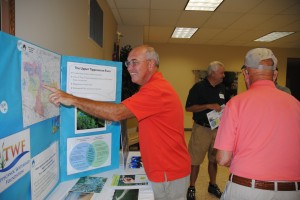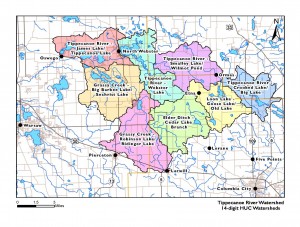Summer Celebration Tops Off Season

Tippecanoe Watershed Foundation supporter Ted Titus looks at a map of the area served by TWF and locates his property.
Tippecanoe Watershed Foundation honored supporters with a summer celebration beginning Saturday morning in the North Webster Community Center Banquet Hall culminating in a cruise around Webster Lake on board the Dixie sternwheeler.
Executive Director Lyn Crighton gave an update on TWF activities and accomplishments during the last year. These include the implementation of more than 20 water quality projects to stop pollution at its source on the land. A question and answer period followed. A social time was spent savoring delicious appetizers and desserts by the Cake Lady, North Webster, at tables decorated with flower arrangements by Sue’s Creations.
The upper Tippecanoe River watershed covers 114 square miles and includes portions of Kosciusko, Whitley and Noble counties and contains more than 50 lakes and nine lake associations connected via the Tippecanoe River and Grassy Creek.
The watershed is the headwaters of the 225 mile long Tippecanoe River, which flows into the Wabash River, then the Ohio River, then the Mississippi River and empties into the Gulf of Mexico. The river’s clear waters and wooded shores provide rich habitat for the abundance of fish, mussels and wildlife.
Very few streams in the upper Midwest can match the number of imperiled species or the overall species diversity the Tippecanoe River supports. The Nature Conservancy considers the Tippecanoe one of the top 10 rivers in America to preserve.
The foundation was founded in 1997 by lake leaders who realized to protect and enhance the Lake Tippecanoe community, a larger vision – a focus on the entire watershed – was needed. TWF has been successful in obtaining grants and raising the necessary funds for scientific research studies and construction of more than 50 water quality improvement projects in the watershed. But there is more to do and TWF has a plan for accomplishing additional water quality goals. Projects aimed at keeping pollution out of local waterways will provide a long-term benefit to the lakes and watershed.
Executive Director Lyn Crighton noted, “Reducing or reversing the effects of pollution in our lakes and rivers may take generations. But the larger the problem gets before we address it, the more costly it will be to fix, and the longer it will take to restore. The sooner we act to reverse these conditions, the greater our likelihood of measurable success.”
Officers of TWF are president Natalie Fierek, vice-president Joe Tynan, secretary Mike Musgrave, and treasurer Bob Schwartz. Board members include Vicki Bolles, Mike Brill, Chuck Brinkman, Mark Ennes and Terry Frederick. Also on the board are Jane Loomis, Peggy Michel, Aileen Meier, Jim Racine, Jim Siegfreid, Dave Smith, Wayne Walston and Jennifer Zartman-Romano.
An office is maintained in the North Webster Community Center and staff includes Crighton and Administrative Assistant Wendi Tomasik. Watershed conservationists are Sam St. Clair, Wayne Stanger and Scott Zeigler.

